Author: Amanda Ahne
Bi-Weekly Geopolitical Report – Introducing the U.S. Space Force (January 29, 2024)
by Daniel Ortwerth, CFA | PDF
On December 20, 2019, something extremely rare happened in the United States Armed Forces: An entirely new branch of service was born. For context, the Army, Navy, and Marine Corps were born by acts of the Continental Congress in 1775. The Coast Guard came into being by act of the first U.S. Congress in 1790, and the relatively young Air Force was born by a similar act of Congress in 1947. Clearly, these are very rare events, so it was a historic occasion when Congress authorized the establishment of the U.S. Space Force (USSF) as an independent branch of the U.S. Military just four years ago.
We begin this report by discussing the background of the USSF, including how its birth was similar to that of the U.S. Air Force (USAF) and how its relationship with the USAF is similar to the Marine Corps’ relationship with the Navy. We also discuss why a new service branch was deemed necessary and what it says about the future of space warfare. As always, we wrap up with a discussion of the implications for investors.
Don’t miss our accompanying podcasts, available on our website and most podcast platforms: Apple | Spotify | Google
Daily Comment (January 29, 2024)
by Patrick Fearon-Hernandez, CFA, and Thomas Wash
[Posted: 9:30 AM EST] | PDF
Our Comment today opens with news that an Iran-backed militant group has killed several U.S. troops in Jordan, boosting the chance that the Israeli-Hamas conflict will broaden. We next review a range of other international and U.S. developments with the potential to affect the financial markets today, including the forced liquidation of a major Chinese housing developer and a few words on the Federal Reserve’s policy meeting this week.
Israel-Hamas Conflict: In sympathy for the Hamas militant government now being attacked by Israel in retaliation for its October 7 attacks, an Iran-backed militant group in Syria launched a drone strike against a U.S. military base in northern Jordan yesterday, killing three U.S. troops and injuring dozens. Iran this morning has tried to distance itself from the strike, but the casualties will surely put heavy pressure on the Biden administration to retaliate against Iranian interests, potentially broadening the Israel-Hamas war into a regional conflict.
- Separately, Israeli intelligence reports shared with the U.S. reveal that at least a dozen employees of the United Nations Relief and Work Agency participated in Hamas’s October 7 attacks on Israel. Moreover, the reports indicate that UNRWA, which is the UN’s organization to help Palestinian refugees, is riddled with staff members who have ties to Islamist militant groups.
- Taken together, the U.S. troop casualties and the intelligence reports have ratcheted up investor concerns about a broader Middle East conflict so far this morning. Gold and crude oil prices initially rose on the news, although oil prices are now trading slightly lower for the day.
European Union: Manfred Weber, leader of the center-right European People’s Party (EPP) that is expected to place first in the European Parliament election in June, said in an interview last week that Europe needs to focus more on developing its own, independent military power outside the North Atlantic Treaty Organization, so it could defend itself even if the U.S. refused to come to its aid. Importantly, Weber even suggested that the EU develop its own nuclear weapons, perhaps under the leadership of the U.K. and France, which are already nuclear powers.
- As we have written many times, we think the most likely scenario going forward is that the growing U.S.-China rivalry fractures the world into a U.S.-led bloc consisting mostly of large, rich, highly developed liberal democracies and a few closely related emerging markets, and a China-led bloc consisting largely of authoritarian, commodity-focused emerging markets and frontier markets.
- However, if former President Trump is elected U.S. president in November, his first-term policies suggest he could renege on the U.S.’s alliance commitments, leaving the U.S. isolated and alone or scrambling to rebuild an alternative alliance structure while its former allies turn distrustful and adversaries like China and Russia keep rapidly building their armed forces. In this case, the EU, the non-U.S. NATO countries, Japan, and other former U.S. allies could be cut adrift and feel they’ve been left to defend themselves.
- We think leaders in the Chinese bloc hope for such an outcome, thinking they could then dominate the former U.S. allies, but Weber’s statements show that such a development could backfire on the Chinese bloc. If a dismantling of the U.S. bloc prompts the EU, the U.K., Japan, South Korea, Australia, and other former allies to develop or expand their own nuclear weapons, the Chinese and Russians would suddenly feel they are surrounded by dangerous enemies. The result would likely be a global nuclear arms race.
Germany: The far-right, anti-immigrant Alternative for Germany (AfD) party unexpectedly lost a district election in the state of Thuringia, dashing the fast-rising group’s hope to secure control of a local government for only the second time in its history. Mainstream voters have recently rallied against the AfD following revelations that it has explored a plan for mass deportations of German residents with foreign backgrounds, including citizens. However, the AfD could quickly recover from the Thuringia loss and continue to draw new support.
Japan: As Japanese stocks continue to perform strongly, we think the rise in prices partly reflects unexpectedly strong profits and productivity. Complementing those positive trends, new research shows that the number of Japanese companies offering stock as part of their employee compensation surged to 767 by August 2023, up from just 110 in 2015. If stock-based pay helps increase Japanese workers’ engagement and incentives, the move could be an additional reason for Japanese stocks to keep rising.
China: A court in Hong Kong today ordered the liquidation of giant, highly indebted housing developer China Evergrande (3333.HK, HKD, 0.163), about two years after the company’s default on its dollar bonds kicked off the financial crisis in China’s real estate market. After many years of debt-fueled overbuilding, the resulting heavy debt load and market retrenchment are now a major headwind for China’s economy, and, by extension, global demand.
China-Taiwan: As China continues to ramp up its military, economic, and diplomatic pressure on Taiwan to thwart any independence moves, the Taiwanese military this week inducted its first one-year draftees. To improve the quality of its troops, Taiwan in late 2022 increased its compulsory military service from just four months to one full year. The island is also trying to boost its arsenal of weapons to deter any potential Chinese invasion or blockade.
U.S. Monetary Policy: The Fed this week holds its latest policy meeting, with its decision due on Wednesday at 2:00 PM EST. The policymakers are widely expected to leave the benchmark fed funds interest-rate target unchanged at its current range of 5.25% to 5.50%. The focus for investors will be on the decision statement and Chair Powell’s following press conference, either of which could provide clues as to when the Fed will finally start to cut rates and reduce its balance sheet runoff. Many investors expect those moves as early as March, but we continue to think they’ll come a bit later than that.
U.S. Military: In its 2024 Index of U.S. Military Strength, the Heritage Foundation has assessed that the country’s military is “not ready to carry out its duties effectively” and that its condition has “worsened over the past two to three years.” Issued last week, the report also faults U.S. leaders for not matching the renewed commitment to defense being demonstrated by allies such as Japan, Germany, Poland, and Lithuania.
- The report comes as all kinds of data also points to the increasing strength and aggressiveness of adversarial countries such as China, Russia, Iran, and North Korea.
- We continue to believe that a growing popular awareness of the global threats and the U.S. military shortcomings could prompt a stronger, more urgent effort to rebuild the country’s defense capability, with positive impacts for stocks in the industrial, technology, and other sectors that focus on selling to the military.
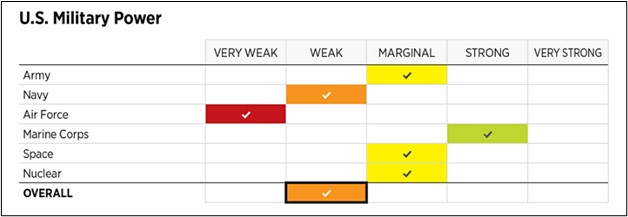 (Source: Heritage Foundation, 2024)
(Source: Heritage Foundation, 2024)
Daily Comment (January 26, 2024)
by Patrick Fearon-Hernandez, CFA, and Thomas Wash
[Posted: 9:30 AM EST] | PDF
Good morning! Wall Street cheers better-than-expected inflation news. Meanwhile, Novak Djokovic’s perfect streak in the Australian Open came to an abrupt end. In our Comment, we explain why optimism should be measured. We also delve into the regulatory storm clouds over Big Tech and dissect the ongoing move toward rate hikes by the Bank of Japan. Plus, we include your usual data for a well-rounded start to your day.
Recession to Paradise? Defying expectations, the economy not only remained in expansion territory in 2023, but it actually accelerated.
- U.S. GDP surged 2.54% in 2023, exceeding analysts’ forecasts and comfortably surpassing the previous year’s 1.9% rise. This robust performance, fueled by strong consumer spending and business investment, has defied fears of recession and has demonstrated the economy’s resilience in the face of tighter monetary policy. Sustained growth coupled with falling inflation have revived hopes for a soft landing, even as geopolitical and trade uncertainties linger. This brighter outlook has fueled a surge in stock prices and expectations for lower interest rates, which have provided a boost to risk assets.
- Thursday’s figures have given investors plenty to cheer about, but beneath the surface, there are still signs that the economy isn’t humming along as smoothly as it might appear. Despite strong job growth headlines, in 2023 revisions lowered payrolls in all but one month, raising concerns about data accuracy. Further casting doubts on the economy’s health, regional Fed data like the Chicago National Activity Index and New York Fed Empire Manufacturing Index revealed weak economic activity. Moreover, Gross Domestic Income, another measure of growth, has consistently lagged behind Gross Domestic Product, suggesting potential underlying issues.
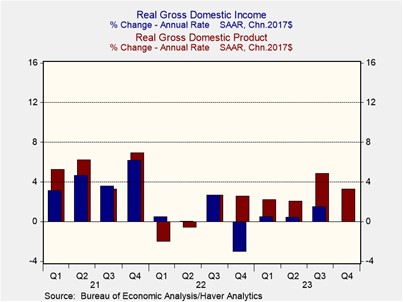
- Recessions can arise unexpectedly, even in the presence of positive indicators. A prime example is the 1973 downturn, which became the third-longest on record, when the U.S. economy added 313,000 jobs during the first month. Similarly, there was positive economic data leading up to the 2008 recession. We anticipate a slowdown in the U.S. economy rather than a full-blown downturn, and we remain optimistic about the potential for equities, particularly small and mid-caps. While recent economic data has been encouraging, it is important for investors to exercise caution and not become overly optimistic.
Regulators Take On AI: Concerns over market dominance have prompted regulators to launch an investigation into the AI practices of major tech firms.
- The FTC has initiated an inquiry into Big Tech’s aggressive acquisition practices concerning smaller AI firms. This investigation will scrutinize how industry giants like Microsoft (MSFT, $404.87), Alphabet (GOOG, $153.64), and Amazon (AMZN, $157.75) exploit their market dominance to procure smaller AI competitors, raising concerns about potential consumer harm and innovation suppression. The agency’s heightened attention to AI aligns with similar probes opened by U.K. and EU regulators, reflecting a growing chorus of concern about the tech giants’ tightening grip on the rapidly evolving AI landscape.
- Emerging language-learning startups, heavily reliant on Microsoft, Alphabet, and Amazon for crucial infrastructure, face an alarming vulnerability to hostile takeovers. These tech giants controlled two-thirds of the funding for AI firms in 2023, according to Pitchfork data, giving them immense leverage over fledgling companies. Big Tech’s control over cloud computing further intensifies the takeover risk for AI startups who heavily rely on these services for their core operations. A study by Deloitte revealed that 70% of companies derive their AI capabilities from cloud-based software, while 65% utilize cloud services to construct AI applications.
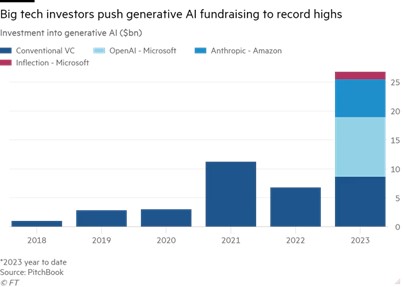
- Amidst the prevailing optimism surrounding AI-related enterprises, the outlook may be considerably more nuanced than initially perceived by investors. As major tech companies brace for heightened government scrutiny, with regulatory bodies collaborating to enhance oversight, the impact on tech-stock valuations remains uncertain. While acknowledging the market’s anticipation of potential upside in these stocks over the next few years, we believe that much of this optimism is already priced in. Consequently, while these companies may still present opportunities for capital gains, we foresee other sectors offering potentially superior relative returns in the future.
BOJ’s Hawkish Turn: While most developed central banks are looking to pivot toward dovish policy, the Bank of Japan hints that it may be going in the other direction.
- The Bank of Japan’s latest minutes hint at a possible turning point in monetary policy, as members debated the terms of exiting their ultra-loose quantitative easing (QE) program. Although disagreement persists, growing optimism about hitting their inflation target suggests a shift might be closer than previously thought. While some committee members proposed raising short-term rates and leaving long-term borrowing costs low, others urged caution, citing concerns about market turbulence if the bank stops buying risky assets. This split opinion suggests a gradual exit from QE might be more likely than a sudden shift.
- That said, recent Japanese price data offers mixed signals about the future path of inflation. Tokyo’s core Consumer Price Index (CPI) rose 1.8% year-over-year, well below the central bank’s target of 2.0%. Meanwhile, the annual increase in producer prices reached 2.4% in December, matching the previous month’s nearly nine-year high. With mixed economic signals swirling, policymakers are putting extra weight on sustainable wage increases as a potential indicator of lasting inflation. Ongoing negotiations with Rengo, Japan’s largest union, could be the tipping point. If they secure their sought-after 5% wage hike, then this could be enough to convince policymakers that inflation has truly found its footing.

- Japanese investors, major players in the U.S. and European bond markets, face potential asset relocation if the Bank of Japan tightens monetary policy. This could trigger a domino effect in global debt markets with rising yields and currency fluctuations. However, the BOJ’s delay in this shift offers welcome news for the yen (JPY), potentially strengthening it and boosting returns for dollar-based investors who hold Japanese assets. The April timeline may be etched in market forecasts, but we see a different picture. Our conviction is that the BOJ will postpone its tightening path until summer, giving ample time for domestic data to solidify.
Other News: Despite growing skepticism from U.S. officials, Russian President Putin has hinted at a possible shift toward peace talks with Ukraine. This cautiously optimistic development follows a recent U.S.-China collaboration on AI regulation and Red Sea issues, suggesting a potential thaw in tensions. Meanwhile, Brazil is mediating a territorial dispute between Guyana and Venezuela, offering hope for further conflict reduction in South America. In short, geopolitical risks are starting to ease.
Business Cycle Report (January 25, 2024)
by Thomas Wash | PDF
The business cycle has a major impact on financial markets; recessions usually accompany bear markets in equities. The intention of this report is to keep our readers apprised of the potential for recession, updated on a monthly basis. Although it isn’t the final word on our views about recession, it is part of our process in signaling the potential for a downturn.
The Confluence Diffusion Index increased from the previous month, suggesting that economic conditions are improving. The December report showed that six out of 11 benchmarks are in contraction territory. Last month, the diffusion index increased from -0.2727 to -0.1515, slightly below the recovery signal of -0.1000.
- Long duration assets received a boost from dovish Fed talk.
- Manufacturing production was weak, but demand for goods has ticked up.
- Jobs data reinforces views that the labor market is resilient.
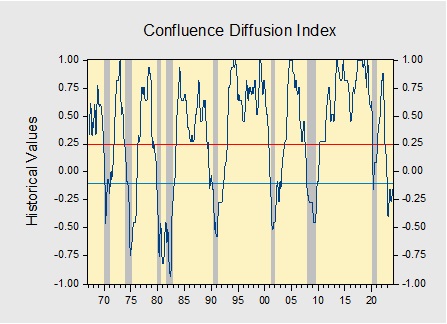
The chart above shows the Confluence Diffusion Index. It uses a three-month moving average of 11 leading indicators to track the state of the business cycle. The red line signals when the business cycle is headed toward a contraction, while the blue line signals when the business cycle is in recovery. The diffusion index currently provides about six months of lead time for a contraction and five months of lead time for recovery. Continue reading for an in-depth understanding of how the indicators are performing. At the end of the report, the Glossary of Charts describes each chart and its measures. In addition, a chart title listed in red indicates that the index is signaling recession.
Daily Comment (January 25, 2024)
by Patrick Fearon-Hernandez, CFA, and Thomas Wash
[Posted: 9:30 AM EST] | PDF
Good morning! Wall Street is evaluating the latest GDP data and Jim Harbaugh’s return to coach the L.A. Chargers is expected to electrify the NFL. Today’s commentary dives into the bond market’s potential tantrum after another disappointing auction, discusses the ECB’s recent policy decision, and explores how escalating national security anxieties may slow the rally in chip-related stocks. As usual, our report concludes with the latest international and domestic data.
Clouds on the Horizon? Another poor showing at a Treasury auction could foreshadow a drop of enthusiasm for equities.
- Yields on long-duration government securities have rebounded as growing bond issuance and doubts about rate expectations weigh on bond prices. On Wednesday, a U.S. Treasury auction of $61 million of five-year bonds failed to meet expectations. The lower-than-expected demand has led to concerns that the market is saturated with Treasuries. This comes on the heels of an announcement of a heavier borrowing schedule from February to April and expectations that the Federal Reserve may not cut rates as aggressively as the market anticipates. As a result, the 30-year yield rose to the highest rate year-to-date.
- The sluggish demand in recent government bond auctions casts doubt on the sustainability of the December 2023 plunge in bond yields. The 10-year Treasury note’s yield slumped over 80 basis points since October, fueled by optimism for the easing monetary policy later in 2024. However, stronger economic data and inflation worries prompted policymakers to temper dovish talk, dampening speculation of an immediate shift. Hawkish comments sent the CME FedWatch Tool’s estimate for a Q1 rate cut plummeting from above 70% to just 40% as of today.
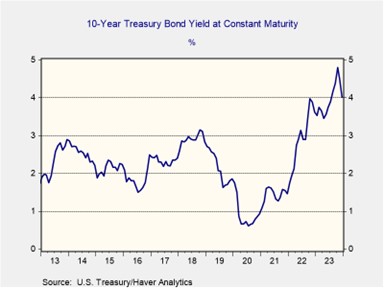
- The stock market’s recent sunshine might face a harsh winter from rising interest rates. A growing supply of bonds coupled with waning demand is creating a perfect storm that may force the Fed to consider changing course sooner rather than later. While some policymakers, like Dallas Fed President Lorie Logan, have advocated for a more cautious approach, such as slowing down the pace of quantitative tightening, others on the committee seem to favor a possible cut in policy rates. This internal tug-of-war will play out in next week’s FOMC meeting as Fed officials grapple with how to conduct policy going forward.
ECB Not Ready to Backdown: The European policymakers may be more willing to stick to higher-for-longer rates than the market anticipates.
- The European Central Bank left its benchmark policy rate unchanged. The decision was in line with market expectations as traders are currently pricing in the central banks’ first rate cut in June. During the press conference, ECB President Christine Lagarde emphasized that the central bank is focused on achieving its 2% target. Lagarde threw cold water on market hopes for an April rate cut, suggesting the bank may wait until the summer before it pivots. However, she maintained that the committee will remain data-dependent when deciding future policy and is prepared to make changes if necessary.
- While Germany and France, Europe’s largest economies, got off to a slow start this year, investors are still buying up government bonds in the region. The latest eurozone Purchasing Managers’ Index (PMI) indicates that the region is currently experiencing contraction, suggesting that economic growth remains sluggish. This weakness is particularly evident in Germany and France, whose PMI readings of 45.4 and 47.1, respectively, fall well below the contraction threshold of 50. Despite ongoing concerns, a promising development emerges in the eurozone periphery. Countries like Italy and Spain, once burdened by high-risk premiums, are witnessing declining bond yields due to anticipated reductions in their debt-to-GDP ratios over the next two years.

- While April rate cuts remain widely expected from the European Central Bank, the bank retains the flexibility to delay if economic data dictates. Despite tepid regional output, fears of a deep recession lack strong evidence. The unemployment rate sits near record lows, suggesting that the slowdown has not spilled over into labor markets. Furthermore, the narrowing gap in yields between core and peripheral eurozone countries, even with the planned March end of PEPP, reduces the risk of diverging borrowing costs and financial instability within the eurozone. As a result, the ECB is better positioned to remain tighter for longer than its American counterpart.
Global Chips: The West’s potential alliance against China and Russia could hinder chipmakers’ ability to meet audacious earnings expectations.
- Despite a growing effort to curtail access, the U.S. is finding it increasingly challenging to stop its rivals from obtaining high-quality chips crucial for their military and industrial development. In 2023, Russia imported over $1 billion of these strategically important components, accounting for more than half of its total chip imports, potentially fueling its war efforts in Ukraine. Adding to the concerns, Dutch lithography giant ASML (ASML, $847.31) ramped-up semiconductor equipment sales to China, in spite of an agreement between the U.S. and the Netherlands to limit shipments.
- Navigating the complexities of coordinated export controls in a fragmented world poses a growing challenge for the U.S. and its allies. Competing interests and shifting partnerships can make effective implementation difficult, even when national security concerns are at stake. This is evident in the case of leading chipmakers like Nvidia (NVDA, $613.62) and Intel (INTC, $49.09), where a quarter of their revenue originates from China. Restricting their ability to sell advanced chips in this crucial market could not only jeopardize their ambitious growth plans but also raise concerns about the effectiveness of such policies in achieving their intended strategic goals.

- Despite this policy’s unsurprising failure, governments may be forced to take a tougher stance with firms, potentially through stricter regulations or financial penalties, to achieve their desired outcomes. Speaking at the Reagan National Defense Forum in California, U.S. Secretary of Commerce Gina Raimondo warned chipmakers that she would like to stop any company looking to aid China’s bid to advance its own AI capabilities. Raimondo’s statement underscores the potential for stricter export controls, a measure not unprecedented in history. Similar restrictions were implemented during World War II and beyond to address critical national security needs. Concerns about new restrictions on chip exports could dampen the recent euphoria surrounding domestic chipmakers.
Other news: South Korean lawmaker Bae Hyun-jin was attacked on Thursday in a sign of growing political hostilities in the country. The Federal Reserve hiked rates in its Bank Term Lending Facility on Thursday as it looks to curtail arbitrage trading. The move highlights the growing concerns policymakers have about moral hazard problems when it comes to backstops.
Daily Comment (January 24, 2024)
by Patrick Fearon-Hernandez, CFA, and Thomas Wash
[Posted: 9:30 AM EST] | PDF
Our Comment today opens with items related to the Russia-Ukraine war. We next review a wide range of other international and U.S. developments with the potential to affect the financial markets today, including a surprise easing of monetary policy in China and the latest on the U.S. presidential election following New Hampshire’s primary election yesterday.
Russia-Ukraine War: Reports today suggest a Russian military plane may have been shot down by Ukrainian forces over Russian territory close to the border with Ukraine, with no survivors. According to Russian officials, the plane was carrying 65 Ukrainian prisoners of war who were about to be part of a Russia-Ukraine POW exchange. That hasn’t yet been verified, but if found to be true, it could be a major embarrassment for Ukrainian President Zelensky and potentially increase domestic pressure on him to begin peace talks.
NATO-Sweden: As we flagged in yesterday’s Comment, the Turkish parliament last night approved Sweden’s bid to join the North Atlantic Treaty Organization. Once Turkish President Erdoğan signs the accession protocol in the coming days, the only hurdle left for Sweden would be to gain Hungary’s approval. Hungarian Prime Minister Orbán has invited Swedish officials to discuss the accession, but a vote still hasn’t been scheduled in the Hungarian parliament.
Israel-Hamas Conflict: Hamas officials yesterday told international mediators that they would consider trading some of the Israeli hostages the group still holds in return for a significant pause in fighting. The statement marks a shift for Hamas, as it had previously said it would only consider releasing more hostages as part of a permanent, comprehensive peace deal with Israel. Nevertheless, it isn’t clear whether the Israeli government will accept the deal, or under what terms. For now, the fighting is set to continue, as will the risk of a broader regional conflict.
- Separately, the U.S. carried out three different airstrikes last night against Iran-backed Kataib Hezbollah militants in Iraq, just as it has been carrying out strikes on Iran-backed Houthi rebels in Yemen.
- The strikes against Kataib Hezbollah follow multiple attacks the group has staged against U.S. forces in the region, which have caused multiple injuries to U.S. personnel. To reiterate, such strikes and counterstrikes mean there is still a risk that the fighting between Israel and Hamas could spread throughout the region.
China: The People’s Bank of China today unexpectedly slashed its bank reserve requirement for the third time since last September, cutting the standard to 7.0% from 7.4% previously. PBOC chief Pan Gongsheng also signaled the central bank will soon cut key interest rates. The moves may give some boost to the Chinese economy and financial markets, but slightly looser monetary policy is unlikely to overcome the big economic headwinds China is currently facing.
- Separately, technology giant Alibaba (BABA, $74.02) saw its share price jump 7.9% yesterday, and pre-market activity suggests the price gains will continue today. That follows reports that co-founders Jack Ma and Joe Tsai have been aggressively buying shares.
- As we noted in yesterday’s Comment, the Chinese government has reportedly been pressuring state-owned firms to buy shares and buoy the flagging market. It’s not inconceivable that high-profile individual owners and investors could also be under pressure to buy.
South Korea: Conservative President Yoon Suk Yeol is facing a growing scandal after a left-wing pastor secretly recorded a video of Yoon’s wife accepting the gift of a $2,200 handbag in violation of the country’s anti-graft laws. The scandal is important because it could complicate Yoon’s effort to ensure his party gains control of the national legislature in the April elections.
Eurozone: The composite “flash” purchasing managers’ index for January rose to a seasonally adjusted 47.9, marking its highest level in six months and improving from 47.6 in December. Like most major PMIs, the eurozone’s is designed so that readings above 50 indicate expanding activity. With its improvement in January, the composite PMI suggests the eurozone’s recent economic downturn is easing a bit, but output is still falling overall. The improvement in January came as manufacturing improved a bit but service activity weakened.

Germany: Deutsche Bahn train conductors today launched a six-day strike over working hours, marking the worst labor action at the railroad in thirty years. The strike is already disrupting freight and passenger service in Germany and could be a further headwind for the country’s struggling economy.
U.S. Politics: In yesterday’s New Hampshire primary election for the Republican Party, former President Trump won with about 54.5% of the vote, while former UN Ambassador Haley came in second with about 43.2%. Nevertheless, Haley vowed to fight on, so it looks like the pair will again face off in Haley’s home state of South Carolina, which holds its primary on February 24.
- While it increasingly appears that Trump will be the ultimate Republican nominee, Haley’s performance in New Hampshire and in last week’s Iowa caucuses have highlighted her strength with right-leaning independents and moderate Republicans.
- Resistance from those groups could be a weakness for Trump in his likely rematch with President Biden in November’s general election.
U.S. Cryptocurrency Market: The price of Bitcoin (BTC, $39,709.17) fell about another 3% yesterday, bringing its total decline over the last two weeks to approximately 15%. In part, the drop in value reflects investors taking profits after the Securities and Exchange Commission approved spot exchange-traded Bitcoin funds on January 11. The drop also probably reflects some disappointment as flows into those ETFs haven’t met expectations.

U.S. Entertainment Industry: The Academy of Motion Picture Arts and Sciences yesterday released its Oscar award nominees, with “Oppenheimer” pulling in 13 different nominations. Among other top films, “Poor Things” got 11 nominations, “Killers of the Flower Moon” received 10, and “Barbie” got eight. Release of the nominees often gives a short-term boost to the films and movie attendance.
Keller Quarterly (January 2024)
Letter to Investors | PDF
About 125 years ago, a reporter spied J.P. Morgan on the streets of New York and ran over to get a prediction and a quote. “What will the stock market do?” the reporter asked the great banker and investor. “It will fluctuate,” was Morgan’s droll reply. The reporter dutifully reported the quotation but was disappointed in its generality. He was hoping to get a scoop! He anticipated getting a prediction from the man who knew the stock market better than almost anyone.
J.P. Morgan’s response has been ridiculed over the years, said to be both true and useless. I disagree. The great man did speak the truth, but he also gave us a most useful observation. The reporter was on a fool’s errand to think that this expert on the stock market could predict the future simply because he was learned. In this folly the reporter has had many followers. Many business reporters in print and television continue to press “experts” for predictions of the future. Morgan was not going to take the bait. He knew that the best thing an investor could do was to recognize that the stock market would fluctuate…and leave it at that.
Then why invest in stocks if all they’re going to do is fluctuate? You invest because you believe that over time the U.S. economy and the great companies within it will grow. Time is the investor’s friend. But investment is not what J.P. Morgan’s reporter and most daily viewers of CNBC are interested in. They want to know what the stock market is going to do tomorrow so they can speculate in stocks. Speculation requires a guess as to what a stock or an index will do in the very near future. Investment requires a calculation of the likely returns a company’s shareholders will receive over time. Speculators worry about stocks fluctuating because they may fluctuate in the wrong direction. Investors don’t worry about short-term fluctuations in prices. In fact, if the fluctuations are large enough, investors may use them as opportunities to either buy or sell.
This was illustrated by Benjamin Graham, the father of our profession, in his wonderful book, The Intelligent Investor. He tells us to imagine that we own an interest in a business, and that we have a partner in that business who is a benign, but insane, man named Mr. Market. Every day, Mr. Market decides to offer a price at which he is willing to buy your stake in the business or, in the alternative, sell you some more. The price he offers changes daily, depending on his mood. Some days he’s feeling greatly optimistic. Some days he is fearful that all will be lost. Thus, the price will bounce all over the place, often in the absence of any information that anything has changed.
Most of the time you can ignore Mr. Market. But a careful study of the business you own with him should lead you to conclude that, occasionally, when his offer price is absurdly high or low, you should take advantage of his offer. Graham concluded that most of the time an investor “will do better if he forgets about the stock market and pays attention to the dividend returns and to the operating results of his companies.”
We have often seen the entire stock market behave like Mr. Market, even in recent months. On July 31 of last year, the S&P 500 (one of the broadest indexes of the U.S. stock market) closed at 4589. About three months later, on October 27, it closed at 4117, about 10.3% less, on virtually no change in the economy or business fundamentals. During that time frame, there was no change in the FOMC’s fed funds rate. All that had changed was Mr. Market’s increasing worry that the Fed might raise rates some more and hurt the economy. After October 27, Mr. Market’s worrying began to abate, and he began to be optimistic that the Fed might actually start to cut its fed funds rate. Thus, over the next 2 ½ months to January 17, the S&P 500 rose 15.1% to a close of 4739. Did much of anything change? No. The fed funds rate is the same as it was on July 31 of last year. All that changed was Mr. Market’s mood.
We have sought to build an investment process that is founded on Benjamin Graham’s analysis of J.P. Morgan’s observation: stock prices will fluctuate, but often not for any good reason other than the emotions of the moment. What we constantly remind ourselves is that we are buying and selling businesses, and that the value of those businesses rarely varies as much as Mr. Market’s daily offer price. We seek to buy and hold outstanding businesses, based on our definition of what makes for an outstanding business. Once we identify such a business, we then look for Mr. Market to offer it to us at an attractive price. If we are patient, he usually does just that.
Fundamental to this process is a belief that the price of a stock and its value are not the same thing. Oscar Wilde once famously said that “a cynic is someone who knows the price of everything, and the value of nothing.” I might say the same about many so-called investors. Knowing the price is easy: Mr. Market sets it for you every day. Knowing the value is the hard part: it is only discerned through a process of disciplined analysis. But, in our opinion, this is the only way to use Mr. Market’s unpredictability to one’s advantage.
Happy New Year to you and yours.
We appreciate your confidence in us.
Gratefully,
Mark A. Keller, CFA
CEO and Chief Investment Officer
Daily Comment (January 23, 2024)
by Patrick Fearon-Hernandez, CFA, and Thomas Wash
[Posted: 9:30 AM EST] | PDF
Our Comment today opens with signs that European leaders are getting more concerned about future Russian aggression. We next review a range of other international and U.S. developments with the potential to affect the financial markets today, including a potential new stock-market stimulus program in China and a few words on U.S. politics.
NATO-Russia: Illustrating how Russia’s invasion of Ukraine has prompted increased defense efforts by European members of the North Atlantic Treaty Organization, the Baltic states of Estonia, Latvia, and Lithuania last week agreed to start building strongpoints, bunkers, and other fixed defensive installations along their border with Russia. The move mirrors a recent decision by Finland to start building defense works on its border with Russia.
- As we wrote in our recent Bi-Weekly Geopolitical Report, an emboldened Russia may eventually be tempted to grab more territory in Europe despite its mauling at the hands of the Ukrainians so far. The possibility of further Russian aggression means the global investment environment will face elevated geopolitical risks in the coming years, but also potential opportunities in assets such as defense stocks and precious metals.
- Separately, German Defense Minister Boris Pistorius has warned that Russia might attack NATO territory even within the next five to eight years. Swedish officials have also been warning their citizens that a war with Russia could be coming. (By the way, we note that Turkey’s parliament is set to vote today on Sweden’s bid to join NATO. If the vote is positive, Sweden would only need a final approval from Hungary to join the alliance.)
- We want to emphasize that we don’t think further Russian aggression is certain. However, these reports do suggest that officials in Europe are becoming more concerned.
China: Responding to the ongoing slide in Chinese stock values, the State Council yesterday called on authorities to take stronger and more effective measures to stabilize markets and boost confidence. They also called for better regulations, more transparency, and additional measures to improve the quality of listed companies. Coupled with a recent surge in stock buying by state-owned firms, the cabinet statement has raised hopes that the government will soon embark on a program to lift prices. Chinese stocks therefore closed modestly higher today.
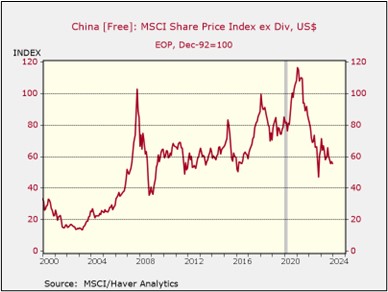
Israel-Hamas Conflict: While Prime Minister Netanyahu has publicly and privately resisted U.S. pressure to tone down Israel’s attacks on Hamas militants in the Gaza Strip, new analysis from the New York Times suggests the intensity of the attacks has indeed declined. The analysis shows that average Palestinian deaths in Gaza are now down to less than 200 per day.
- Of course, the death and destruction is still high enough to spur anti-Israeli attacks by militants around the region, including in southern Lebanon, keeping alive the risk that the conflict could broaden.
- Nevertheless, reduced violence and a more targeted approach by Israel could help to eventually reduce tensions and risks.

Red Sea Shipping: Despite the drop in casualties in Gaza, Iran-backed Houthi rebels in Yemen continue to threaten sympathy strikes on commercial ships in the Red Sea. In response, the U.S. and the U.K. launched a new round of airstrikes on Houthi missile sites and other targets this morning. The strikes mark the U.S.’s eighth attack on Houthi targets over the last several weeks.
European Union: Jean-François van Boxmeer, head of the European Round Table for Industry, has issued a complaint that the 800-billion EUR ($869 billion) NextGen EU pandemic recovery fund is far too difficult to access. According to van Boxmeer, the EU needs to cut the red tape and restructure the fund to get money into its targeted digital and green-tech projects more quickly.
- Indeed, halfway through its planned 2021-2026 life, only about 30% of the fund has been spent on loans and grants.
- That has left the EU with far less fiscal stimulus than the U.S. has had in the same period, which probably helps explain the stronger relative economic growth in the U.S.
France: Farmers’ union FNSEA is launching multiple road blockades and other measures today to protest government red tape and rising production costs. The protests follow similar actions recently in Germany, the Netherlands, Poland, and Romania. They also illustrate some of the rural frustrations that have boosted the support for right-wing populist movements throughout Europe.
Argentina: Key labor unions have announced that hundreds of thousands of workers will go out on strike this week to protest the libertarian economic reforms pushed by President Milei. The country’s courts have already suspended some key reforms, and Milei lacks control of the Argentine legislature, so the mass strike could be a further big impediment to Milei’s effort to reform the crisis-prone economy.
U.S. Politics: New Hampshire today holds the first presidential primary vote of the election season, following Iowa’s caucuses last week. On the Republican side, the latest opinion polls give former President Trump a healthy lead, but former UN Ambassador Nikki Haley is hoping for an upset and follow-on victory in her native South Carolina later.
- In our geopolitical analysis, we write a lot about the rise of right-wing populists around the world, including leaders such as Trump, Italian Prime Minister Giorgia Meloni, and Hungarian Prime Minister Viktor Orbán. However, we usually focus on the populists’ isolationist policies and how they affect international relations.
- An interesting opinion piece in the Financial Times today explores the economic impact of the populists. Specifically, the article notes that even though populist policies could theoretically be negative for the economy, most of today’s populists have presided over good economic growth. The article doesn’t give a definitive answer as to why that has happened, but it’s worth reading the author’s exploration of the topic.
U.S. Fiscal Policy: While it’s widely recognized that expansive federal fiscal policy has been helping buoy U.S. economic growth (reflecting both reduced income taxes and higher spending, especially for various types of entitlements), new analysis reminds us that state and local governments have also been increasing their spending. Key factors boosting state and local spending (and hiring) include infrastructure investment and stronger teacher hiring as schools get back to normal following the COVID-19 pandemic.


